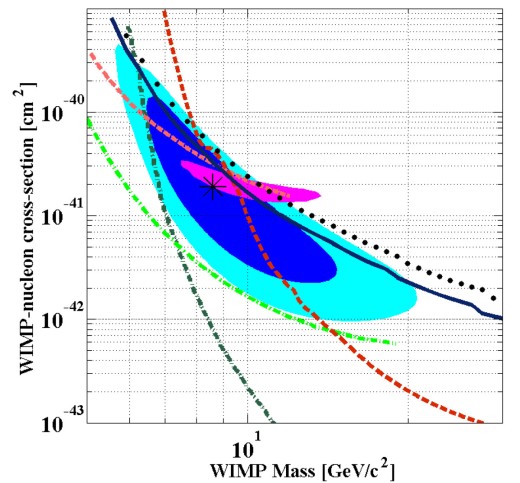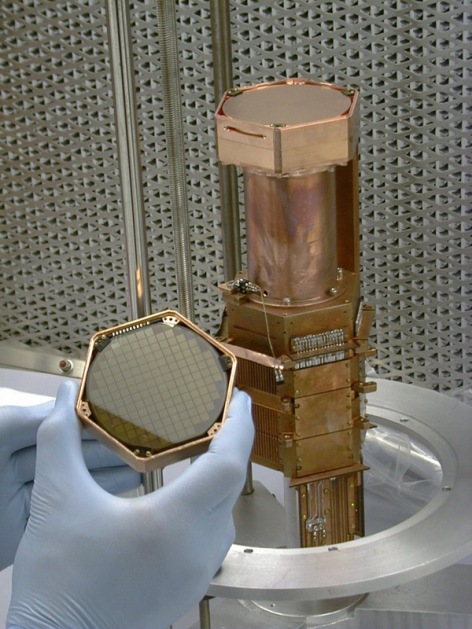Hard on the heels of the Alpha Magnetic Spectrometer (AMS) positron excess and possible dark matter report, we now have a hint of direct dark matter detection from the SuperCDMS Collaboration this month. A recent blog here on darkmatterdarkenergy.com discusses the detection of excess positron flux seen in the AMS-02 experiment on board the Space Shuttle. The two main hypotheses for the source of excess positrons are either a nearby pulsar or dark matter in our Milky Way galaxy and halo.
CDMS-II (CDMS stands for Cryogenic Dark Matter Search) is a direct dark matter detection experiment based in the Soudan mine in Minnesota. The deep underground location shields the experiment from most of the cosmic rays impinging on the Earth’s surface. Previously they had reported a null result based on their germanium detector and ruled out a detection. Now they have more completely analyzed data from their silicon detector, which has higher sensitivity for lower possible dark matter masses, and they have detected 3 events which might be due to dark matter and report as follows.
“Monte Carlo simulations have shown that the probability that a statistical fluctuation of our known backgrounds could produce three or more events anywhere in our signal region is 5.4%. However, they would rarely produce a similar energy distribution. A likelihood analysis that includes the measured recoil energies of the three events gives a 0.19% probability for a model including only known background when tested against a model that also includes a WIMP contribution.”
So essentially they are reporting a possible detection with something ranging from 95% to 99.8% likelihood. This is a hint, but cannot be considered a firm detection as it rises to the level of perhaps 3 standard deviations (3 sigma) of statistical significance. Normally one looks to see a 5 sigma significance for a detection to be well confirmed. If the 3 events are real they suggest a relatively low dark matter particle mass of around 8 or 9 GeV/c² (the proton mass is a little under 1 GeV/c², and the Higgs boson around 126 GeV/c²).

Figure: Error ellipses for CDMS-II and CoGeNT, assuming a dark matter WIMP explanation. Blue ellipses are the 68% (dark blue) and 90% (cyan) confidence levels for the CDMS-II experiment. The purple ellipse is the 90% confidence level for CoGeNT.
The figure shows the plane of dark matter (WIMP, or weakly interacting massive particle) cross-section on the y-axis vs. the WIMP mass on the x-axis. Note this is a log-log plot, so the uncertainties are large. The dark blue region is the 1 sigma error ellipse for the CDMS experiment and the light blue region is the 90% confidence error ellipse. The best fit is marked by an asterisk located at mass of 8.6 GeV/c² and with a cross-section a bit under 2 x 10^-41 cm². But the mass could range from less than 6 to as much as 20 or more GeV/c². And the cross-section uncertainty is over two orders of magnitude.
However, this is quite interesting as the error ellipse for the mass and interaction cross-section from this CDMS-II putative result overlaps well with the (smaller) error ellipse of the CoGeNT results. The CoGeNT experiment is a germanium detector run by a different consortium, but based in the same Soudan Underground Laboratory as the CDMS-II experiment! COGENT sees a possible signal with around 2.8 sigma significance as an annual modulated WIMP wind, with the modulation in the signal due to the Earth’s motion around the Sun and thus relative to the galactic center. The purple colored region in the figure is the CoGeNT 90% confidence error ellipse, and it includes the CDMS-II best fit point and suggests also a mass of roughly 10 GeV/c².
The DAMA/LIBRA experiment in Italy has for years been claiming a highly significant 9 sigma detection of a WIMP (dark matter) wind, but with very large uncertainties in the particle mass and cross-section. However both the COGENT results and this CDMS-II possible result are quite consistent with the centroid of the DAMA/LIBRA error regions.
And both the CoGeNT and DAMA experiments are consistent with an annual modulation peak occurring sometime between late April and the end of May, as is expected based on the Earth’s orbit combined with the Sun’s movement relative to the galactic center.
What we can say at this point is the hottest region to hunt in is around 6 to 10 GeV/c² and with a cross section roughly 10^-41 cm². Physicists may be closing in on the target area for a confirmed weakly interacting dark matter particle detection. We await further results, but the pace of progress seems to be increasing.
References:
https://darkmatterdarkenergy.com/2013/04/07/ams-positron-excess-due-to-dark-matter-or-not/ – Recent first results from AMS for positron excess
http://cdms.berkeley.edu/ – SuperCDMS Collaboration web site
http://arxiv.org/abs/1304.4279 – “Dark Matter Search Results Using the Silicon Detectors of CDMS II”
http://cdms.berkeley.edu/APS_CDMS_Si_2013_McCarthy.pdf – Kevin McCarthy’s presentation at the American Physical Society, April 15, 2013
http://cogent.pnnl.gov/ – CoGeNT website
https://darkmatterdarkenergy.com/2011/06/16/do-we-have-a-cogent-direct-detection-of-dark-matter/ – Discussion of CoGeNT 2011 results
http://arxiv.org/pdf/1301.6243v1.pdf – DAMA/LIBRA results summary, 2013


August 12th, 2013 at 11:03 pm
Monsieur,
Ne pourrait-on pas partir de l’intrication quantique pour aborder la matière noire sous un autre angle ? Si deux particules très éloignées semblent communiquer entre elles à une vitesse supérieure à celle de la lumière pour choisir leur spin, ne peut-on supposer que ces deux particules sont liées par un lien matériel invisible qui court sur d’énormes distances ?
Bien sincèrement.
Isabelle BANCEL
Brest
FRANCE
August 13th, 2013 at 11:19 pm
Thanks for your interesting question.
(For English speakers the question is: Can’t we start from quantum entanglement to look at dark matter from another angle? If two very far apart particles seem to communicate between themselves at a speed greater than the speed of light to choose their spin, maybe we can suppose that these two particles are linked by an invisible material link that covers enormous distances?)
Dark matter would likely not have an effect on two quantum entangled particles of ordinary matter. If their (electromagnetic) spins are entangled, this information would not be transmitted by dark matter since it does not interact through the electromagnetic force. It interacts only through gravitation and perhaps weakly through direct collisions, which would be very rare (very low cross section), as SuperCDMS is trying to detect. Gravitational effects by the dark matter would be much too weak to flip a spin and interfere with the coherence between the two supposed entangled particles. Note that the mass of all the dark matter inside the Earth’s orbit around the Sun is perhaps 17 orders of magnitude smaller than the Sun’s mass, amounting to only the amount of a single small asteriod. Dark matter is much more diffuse than ordinary matter in our solar system.
http://scienceblogs.com/startswithabang/2013/07/03/does-dark-matter-affect-the-motion-of-the-solar-system/
If the particles were part of an experiment anywhere in the solar system and their respective spin states were to be disentangled, or influenced by other matter, it would be ordinary matter since that can be charged and has electromagnetic spin.
August 14th, 2013 at 2:05 am
Monsieur,
Merci beaucoup pour votre réponse.
N’est-il pas exact que le spin quantique ne relève pas de l’électromagnétisme ? C’est une observable quantique.
Ne peut-on donc imaginer le modèle suivant : la création de paires quantiques ne se ferait QUE sur des fils très ténus de matière noire (avec un ordre de grandeur de la constante de Plank), auxquels ces particules resteraient toujours associées et qui pourraient transmettre l’information à une vitesse supérieure à celle de la lumière, avec une dimension pour chaque fil. A moins que la création de paires quantiques ne suscite elle-mēme le fil de matière noire.
Bien sincèrement.
Isabelle CHARLES BANCEL
August 14th, 2013 at 2:29 am
Monsieur, Merci beaucoup pour votre réponse. N’est-il pas exact que le spin quantique ne relève pas de l’électromagnétisme ? C’est une observable quantique. Ne peut-on donc proposer le modèle suivant : la création de paires quantiques ne se ferait QUE sur des fils très ténus (ou enroulés dans une dimension spéciale) de matière noire auxquels ces particules resteraient toujours associées, et qui pourraient transmettre l’information à une vitesse supérieure à celle de la lumière, avec une dimension pour chaque fil. A moins que la création de paires quantiques ne suscite elle-même le fil de matière noire. Bien sincèrement. Isabelle CHARLES BANCEL
August 14th, 2013 at 2:38 am
Planck. Des fils ténus ou enroulés dans une dimension spéciale.
August 14th, 2013 at 6:40 pm
Well, if I follow your French correctly, you are suggesting an underlying scaffolding based on dark matter that supports the quantum entanglement of ordinary matter particles.
The present situation is that we have indications of a deeper physics beyond the Standard Model with hints from the Higgs boson detection, recently discovered B-meson anamolies, along with the questions of what is dark matter composed of, and what is dark energy?
There may well be a deeper underlying reality beyond the Standard Model and described by string theory and reflective of the era of inflation at energies of order 10^16 GeV (proton is 1 GeV) when the 3 non-gravitational forces were becomeing decoupled from one another. This inflationary phase caused spacetime between distant points to expand with hypervelocity (faster than c); this is perfectly allowed by general relativity. (Individual particles with mass must travel at less than the speed of light).
Quantum entanglement is not easy to maintain, because there are external disturbances on particle pairs, such as radiation. At that early time the universe was dominated by very high energy radiation, and this would constantly interact with matter particles and knock them into other energy states, destroying entanglement. But that’s not to say that at some point some entangled pairs didn’t survive.
Yet they are always exposed to a sea of radiation from the cosmic microwave background even today at 2.7 Kelvins which can upset entanglements.
I suspect it is not the dark matter particles themselves which are somehow enabling entanglement, since dark matter density and cross sections are so very low. Rather there is something deeper in the hidden dimensions of string theory which has probably either 6 or 16 additional spatial dimensions beyond the usual 3 with which we are familiar. The entanglement may be a reflection of something happening in these hidden dimensions. But I am no expert in string theory.
Regards,
Stephen
August 15th, 2013 at 2:11 am
Thank you very much for your answer.
En espérant avoir le plaisir et la possibilité de vous interroger à nouveau.
Bien sincèrement.
I.B
September 9th, 2013 at 8:59 pm
[…] observational hints of the possibility of both a light dark matter particle and a heavier one. The SuperCDMS team has announced a possible detection around 8 or 9 GeV. The COGENT experiment has a possible […]